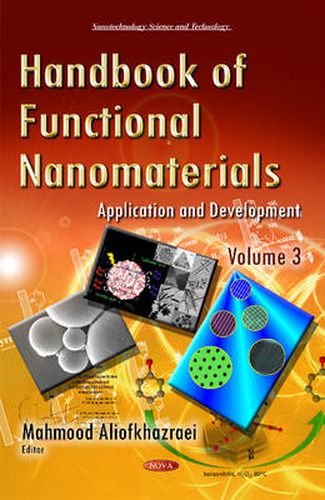Readings Newsletter
Become a Readings Member to make your shopping experience even easier.
Sign in or sign up for free!
You’re not far away from qualifying for FREE standard shipping within Australia
You’ve qualified for FREE standard shipping within Australia
The cart is loading…






This is the third volume of the Handbook of Functional Nanomaterials (4 volume set). Functional nanomaterials appear in our daily lives. These materials mainly include nanocomposites, nanopowders, nanoparticles and nanocoatings. Nanotechnology enables the creation of structures that do not exist in nature, those which cannot be produced by conventional chemistry. Some advantages of this technology are the synthesis of stronger, more adjustable materials as well as lower costs. Nanotechnology is scientific and research development at the atomic, molecular, or macromolecular levels in a dimension range of 1 to 100 nm; the fabrication and application of the structures, equipment, and systems which involve unique characteristics and new applications because of their small or medium dimensions; and the potential for the control and management at atomic scales. Therefore, nanotechnology involves industrial research and development at atomic, molecular, and macromolecular levels. This research aims to create and exploit the structures and systems which involve unique applications due to their small dimensions. The main difference between nanotechnology and other technologies is found within the dimensions and properties of the materials and structures applied to this technology. This volume mainly discusses the application and development of functional nanomaterials. Some of the functional nanomaterials that were discussed in this volume are titania nanostructures, hybrid nanomaterials based on nanoclays, multifunctional nanomedicine, nanocomposites using polypyrrole, metallic nanoparticles, quantum dots, fullerenes and capped nanotubes, graphene, nanocomposite coatings, functionalized carbon nanotube, nanopowders.
$9.00 standard shipping within Australia
FREE standard shipping within Australia for orders over $100.00
Express & International shipping calculated at checkout
This is the third volume of the Handbook of Functional Nanomaterials (4 volume set). Functional nanomaterials appear in our daily lives. These materials mainly include nanocomposites, nanopowders, nanoparticles and nanocoatings. Nanotechnology enables the creation of structures that do not exist in nature, those which cannot be produced by conventional chemistry. Some advantages of this technology are the synthesis of stronger, more adjustable materials as well as lower costs. Nanotechnology is scientific and research development at the atomic, molecular, or macromolecular levels in a dimension range of 1 to 100 nm; the fabrication and application of the structures, equipment, and systems which involve unique characteristics and new applications because of their small or medium dimensions; and the potential for the control and management at atomic scales. Therefore, nanotechnology involves industrial research and development at atomic, molecular, and macromolecular levels. This research aims to create and exploit the structures and systems which involve unique applications due to their small dimensions. The main difference between nanotechnology and other technologies is found within the dimensions and properties of the materials and structures applied to this technology. This volume mainly discusses the application and development of functional nanomaterials. Some of the functional nanomaterials that were discussed in this volume are titania nanostructures, hybrid nanomaterials based on nanoclays, multifunctional nanomedicine, nanocomposites using polypyrrole, metallic nanoparticles, quantum dots, fullerenes and capped nanotubes, graphene, nanocomposite coatings, functionalized carbon nanotube, nanopowders.